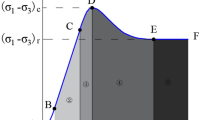This study applies an improved Harris distribution function to describe rock material heterogeneity and randomness of micro-unit damage to determine the rock damage evolution law. A new damage constitutive model is established using the dimensionless Drucker-Prager (D-P) criterion to reasonably measure the strength of rock micro-units, from which we deduce a theoretical expression of the model parameters and discuss their physical meaning. We performed triaxial compression tests on sandstone samples under conventional conditions to validate our model. The results show that the improved Harris distribution function is suitable for describing the damage evolution process of rock material, and its meso-mechanical response is consistent with the macroscopic rock deformation and failure process. The dimensionless D-P criterion is used to define the random variables of the rock micro-unit strength, which reduces the number of independent model parameters and simplifies the parameter determination process and model expression.
Similar content being viewed by others
References
C. A. Tang, W. T. Yang, Y. F. Fu, and X. H. Xu, “A new approach to numerical method of modelling geological processes and rock engineering problems-continuum to discontinuum and linearity to nonlinearity,” Eng. Geol., 49(3), 207-214 (1998).
D. Krajcinovic and M. A. G. Silva, “Statistical aspects of the continuous damage theory,” Int. J. Solid Struct., 18(7), 551-562 (1982).
W. G. Cao, R. Mo, and X. Li, “Study on statistical constitutive model and determination of parameters of rock based on normal distribution,” Chin. J. Geotech. Eng., 29(5), 671-675 (2007).
L. Xiang, W. G. Cao, and Y. H. Su, “A statistical damage constitutive model for softening behavior of rocks,” Eng. Geol., 143-144(8), 1-17 (2012).
H. Zhao, C. Shi, M. Zhao, and X. Li, “Statistical damage constitutive model for rocks considering residual strength,” Int. J. Geomech., 17(1), 04016033.1-04016033.9 (2017)
Y. Q. Zhou, Q. Sheng, X. L. Leng, X. D. Fu, and L. F. Li, “Statistical constitutive model of elastic damage for rock considering residual strength and threshold,” J. Yangtze River Sci. Res. Inst., 33(3) 48-53 (2016).
X. Qi, Mathematical model method, Huazhong University of Science and Technology Press, Wuhan (2002).
H. F. Huang, N. P. Ju, L. Li, J. Xiao, M. Li, J. Bai, and X. Lu, “Improved Harris function based statistical damage softening model for rocks,” J. Eng. Geol., 26(2), 520-527 (2018).
J. Lemaitre, “How to use damage mechanics,” Nuclear Eng. Design, 80(2), 233-245 (1984).
H. M. Zhang, L. N. Lei, and G. S. Yang, “Characteristic and representative model of rock damage process under constant confining stress,” J. China Uni. Mining Tech., 44(1), 58-63 (2015).
P. W. Shen, H. M. Tang, Y. B. Ning, and D. Xia, “A damage mechanics based on the constitutive model for strain-softening rocks,” Eng. Fracture Mech., 216, 106521-106521 (2019).
P. X. Wang, P. Cao, M. Wang, Y. Chen, and C. C. Wang, “Post-peak stress−strain relationship model of rock considering confining pressure effect,” J. Central South Uni., 48(10), 2753-2758 (2017).
F. Gao, X. Xiong, K. P. Zhou, J. L. Li, and W. C. Shi, “Strength deterioration model of saturated sandstone under freeze-thaw cycles,” Rock Soil Mech., 40(3), 926-932 (2019).
Author information
Authors and Affiliations
Corresponding author
Additional information
Translated from Osnovaniya, Fundamenty i Mekhanika Gruntov, No. 4, July-August, 2022.
Rights and permissions
Springer Nature or its licensor holds exclusive rights to this article under a publishing agreement with the author(s) or other rightsholder(s); author self-archiving of the accepted manuscript version of this article is solely governed by the terms of such publishing agreement and applicable law.
About this article
Cite this article
Zhang, H., Chen, S., Wang, L. et al. A Dimensionless Rock Damage Constitutive Model under an Improved Harris Distribution. Soil Mech Found Eng 59, 338–346 (2022). https://doi.org/10.1007/s11204-022-09820-9
Published:
Issue Date:
DOI: https://doi.org/10.1007/s11204-022-09820-9




